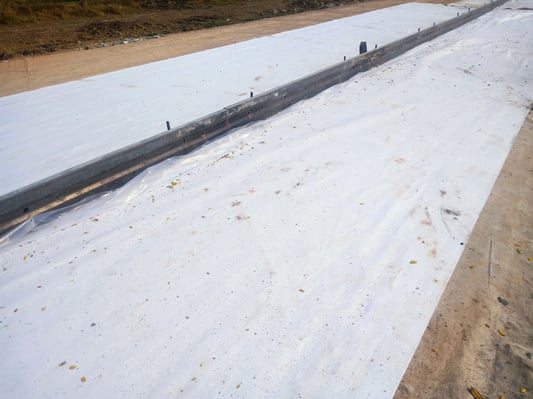Geotextiles are synthetic, permeable materials used in civil construction projects to improve soil characteristics. Geotextiles make poor soils more suitable for construction as they have the ability to separate, filter, reinforce, protect and drain soils.
Geotextiles are useful in many infrastructure works such as roads, landfills, ports, drainage structures and other civil engineering projects.
Types of geotextiles
Geotextiles are made from polymers such as polypropylene and polyester. They are divided into three categories, according to their manufacturing process:
- Tissue
- Non-woven fabric
- Mesh fabric
Other geosynthetics include geonets, geocells, geomembranes, geogrids, etc.
Woven geotextiles are the most common, and their manufacturing methods are similar to clothing textiles. This type of geotextile is made from two sets of parallel threads or threads.
Non-woven geotextiles are made from continuous yarn filaments or short fibers. They are bonded with thermal, chemical or mechanical techniques or a combination of techniques.
Mesh geotextiles are created by interweaving a series of loops of thread. These geosynthetics are made by combining the knitting technique with other methods such as weaving.
Main Functions of Geotextiles

Geotextiles are typically used to improve soil characteristics prior to the construction of landfills, roads, pipelines and earth retaining structures. Geotextiles have several functions, which include filtration, drainage, reinforcement, cushioning, waterproofing and separation.
Reduce the environmental impact of your projects.
Geotextile Separation
This is the main reason why geotextiles are used in construction. When a geotextile is installed between two different soils, it will prevent mixing when water enters the soil strata. In this way, the required characteristics of the soil can be conserved. By separating fine subgrade soil from aggregates, as is the case with roads, geotextile preserves the drainage properties and strength of the base material.
These geotextiles have special thickness and permeability properties to prevent soil contamination and allow water flow without compromising structural integrity. Some application areas of geotextiles include:
- Between embankments and stone base layers
- Between subgrade and base on paved and unpaved roads
- Between subgrade in railways
- Between geomembranes and sand drainage layers
Geotextile Filtration
The filtration properties of geotextiles are used when water needs to move in both directions. These types of geotextiles can be woven or non-woven and are used to prevent fine aggregates from moving between soil layers.
The two main properties of geotextiles that involve infiltration are porosity and permeability. Depending on these properties, geotextiles can also promote the lateral flow of water, dissipating the kinetic energy of the capillary rise of groundwater. The applications of this type of geotextile can be both vertical and horizontal, helping to solve drainage problems along roads and structures.
Geotextile Reinforcement
There are three main factors when designing geotextiles to improve soil characteristics:
- Friction or restriction of movement between the geotextile and the soil
- Supporting any loads present
- Increasing shear strength
The role of geotextile reinforcement is comparable to the role of steel bars in concrete construction. Geotextiles are used in landfills and roads built on poorly classified soils, implementing design parameters provided by a geotechnical engineer.
Geotextile Fencing
Geotextile fabrics can be impregnated with asphalt or other mixtures, which makes them waterproof and capable of restricting the vertical flow of water. For this application, geotextiles must be non-woven. Impermeable geotextiles can be used to prevent contamination of soil or groundwater by above pollutants, as well as helping to prevent the loss of drinking water due to evaporation.
Geotextile Applications in Civil Engineering Projects

The scope of geotextiles in the field of civil engineering is very broad, including the following applications:
- Roads : Geotextiles are widely used in road construction, reinforcing soil by adding tensile strength. Geotextiles can be used as a quick dewatering layer on the roadbed.
- Railways : Geotextiles are used to separate individual soil layers without impeding the circulation of groundwater where the soil is unstable. This also prevents the layer materials from shifting laterally under the constant shocks and vibrations of passing trains.
- Agriculture : Non-woven fabrics are used for mud control and to improve paths and trails used by livestock or light traffic.
- Drainage : Geotextiles are used as filtration mechanisms for drainage in roads, highways, earthen dams, reservoirs, retaining walls, drainage ditches and many other applications.
- Coastal work : Geotextiles can help prevent erosion on the banks of rivers, canals and other bodies of water.
Other common applications of geotextiles include landfills, sidewalks, parking lots, green spaces, recreational facilities, pipe trenches, and duct banks. Since geotextiles help preserve soil conditions, they have a positive environmental impact.

